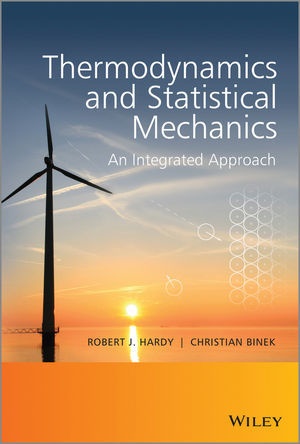Read more
This textbook brings together the fundamentals of the macroscopic and microscopic aspects of thermal physics by presenting thermodynamics and statistical mechanics as complementary theories based on small numbers of postulates. The book is designed to give the instructor flexibility in structuring courses for advanced undergraduates and/or beginning graduate students and is written on the principle that a good text should also be a good reference.
The presentation of thermodynamics follows the logic of Clausius and Kelvin while relating the concepts involved to familiar phenomena and the modern student's knowledge of the atomic nature of matter. Another unique aspect of the book is the treatment of the mathematics involved. The essential mathematical concepts are briefly reviewed before using them, and the similarity of the mathematics to that employed in other fields of physics is emphasized.
The text gives in depth treatments of low density gases, harmonic solids, magnetic and dielectric materials, phase transitions, and the concept of entropy. The microcanonical, canonical, and grand canonical ensembles of statistical mechanics are derived and used as the starting point for the analysis of fluctuations, blackbody radiation, the Maxwell distribution, Fermi-Dirac statistics, Bose-Einstein condensation, and the statistical basis of computer simulations.
Supplementary material including PowerPoint slides and detailed worked solutions can be downloaded online at http://booksupport.wiley.com
List of contents
Preface xiii
Part I Elements of Thermal Physics 1
1. Fundamentals 3
1.1 PVT Systems 3
1.2 Equilibrium States 6
1.3 Processes and Heat 10
1.4 Temperature 12
1.5 Size Dependence 13
1.6 Heat Capacity and Specific Heat 14
Problems 17
2. First Law of Thermodynamics 19
2.1 Work 19
2.2 Heat 21
2.3 The First Law 21
2.4 Applications 22
Problems 26
3. Properties and Partial Derivatives 27
3.1 Conventions 27
3.2 Equilibrium Properties 28
3.3 Relationships between Properties 34
3.4 Series Expansions 40
3.5 Summary 41
Problems 42
4. Processes in Gases 45
4.1 Ideal Gases 45
4.2 Temperature Change with Elevation 48
4.3 Cyclic Processes 50
4.4 Heat Engines 52
Problems 58
5. Phase Transitions 61
5.1 Solids, Liquids, and Gases 61
5.2 Latent Heats 65
5.3 Van der Waals Model 67
5.4 Classification of Phase Transitions 70
Problems 72
6. Reversible and Irreversible Processes 75
6.1 Idealization and Reversibility 75
6.2 Nonequilibrium Processes and Irreversibility 76
6.3 Electrical Systems 79
6.4 Heat Conduction 82
Problems 86
Part II Foundations of Thermodynamics 89
7. Second Law of Thermodynamics 91
7.1 Energy, Heat, and Reversibility 91
7.2 Cyclic Processes 93
7.3 Second Law of Thermodynamics 95
7.4 Carnot Cycles 98
7.5 Absolute Temperature 100
7.6 Applications 103
Problems 107
8. Temperature Scales and Absolute Zero 109
8.1 Temperature Scales 109
8.2 Uniform Scales and Absolute Zero 111
8.3 Other Temperature Scales 114
Problems 115
9. State Space and Differentials 117
9.1 Spaces 117
9.2 Differentials 121
9.3 Exact Versus Inexact Differentials 123
9.4 Integrating Differentials 127
9.5 Differentials in Thermodynamics 129
9.6 Discussion and Summary 134
Problems 136
10. Entropy 139
10.1 Definition of Entropy 139
10.2 Clausius' Theorem 142
10.3 Entropy Principle 145
10.4 Entropy and Irreversibility 148
10.5 Useful Energy 151
10.6 The Third Law 155
10.7 Unattainability of Absolute Zero 156
Problems 158
Appendix 10.A. Entropy Statement of the Second Law 158
11. Consequences of Existence of Entropy 165
11.1 Differentials of Entropy and Energy 165
11.2 Ideal Gases 167
11.3 Relationships Between CV, CP, BT , BS, and alphaV 170
11.4 Clapeyron's Equation 172
11.5 Maximum Entropy, Equilibrium, and Stability 174
11.6 Mixing 178
Problems 184
12. Thermodynamic Potentials 185
12.1 Internal Energy 185
12.2 Free Energies 186
12.3 Properties From Potentials 188
12.4 Systems in Contact with a Heat Reservoir 193
12.5 Minimum Free Energy 194
Problems 197
Appendix 12.A. Derivatives of Potentials 197
13. Phase Transitions and Open Systems 201
13.1 Two-Phase Equilibrium 201
13.2 Chemical Potential 206
13.3 Multi-Component Systems 211
13.4 Gibbs Phase Rule 214
13.5 Chemical Reactions 215
Problems 217
14. Dielectric and Magnetic Systems 219
About the author
Robert J. Hardy and Christian Binek
Department of Physics, University of Nebraska-Lincoln, USA
Summary
This textbook brings together the fundamentals of the macroscopic and microscopic aspects of thermal physics by presenting thermodynamics and statistical mechanics as complementary theories based on small numbers of postulates. The book is designed to give the instructor flexibility in structuring courses for advanced undergraduates and/or beginning graduate students and is written on the principle that a good text should also be a good reference.
The presentation of thermodynamics follows the logic of Clausius and Kelvin while relating the concepts involved to familiar phenomena and the modern student's knowledge of the atomic nature of matter. Another unique aspect of the book is the treatment of the mathematics involved. The essential mathematical concepts are briefly reviewed before using them, and the similarity of the mathematics to that employed in other fields of physics is emphasized.
The text gives in depth treatments of low density gases, harmonic solids, magnetic and dielectric materials, phase transitions, and the concept of entropy. The microcanonical, canonical, and grand canonical ensembles of statistical mechanics are derived and used as the starting point for the analysis of fluctuations, blackbody radiation, the Maxwell distribution, Fermi-Dirac statistics, Bose-Einstein condensation, and the statistical basis of computer simulations.
Supplementary material including PowerPoint slides and detailed worked solutions can be downloaded online at http://booksupport.wiley.com

